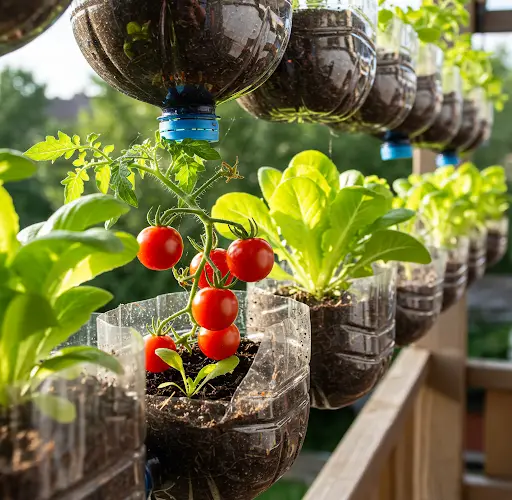No Garden Needed: Turn a Small Wall into a Lush Vertical Vegetable Garden for the Whole Family
In a world where space is increasingly limited—especially in urban environments—growing your own vegetables might seem out of reach. But with a little creativity and a small vertical wall, you can transform even the tightest corner into a thriving vegetable garden that provides fresh, healthy food for your entire family.
This method doesn’t require traditional garden beds, large yards, or even ground soil. All you need is a sunny wall, a few basic materials, and the desire to grow your own food. Vertical gardening is a smart, space-saving way to make the most of small areas, while also beautifying your home with greenery and edible plants.
Why Choose a Vertical Vegetable Garden?
There are many benefits to growing vegetables vertically:
-
Space efficiency: Ideal for balconies, patios, and compact urban homes.
-
Better air circulation: Reduces the risk of disease and mildew.
-
Easier to manage: Less bending and fewer weeds to pull.
-
Pest control: Elevates plants away from ground pests.
-
Aesthetic value: Turns a dull wall into a vibrant, green feature.
Plus, it’s incredibly satisfying to harvest food from your own wall!
What You’ll Need to Get Started
You don’t need expensive materials. Many of the items can be repurposed or found easily at home:
-
Sturdy vertical surface: A fence, brick wall, wooden frame, or metal rack.
-
Plastic bottles, grow bags, or plant pots
-
Strong hooks or mounting hardware
-
Wire mesh, pallets, or old shelves (optional)
-
Potting mix suitable for vegetables
-
Compost or organic fertilizer
-
Seeds or seedlings (leafy greens, herbs, peppers, tomatoes, etc.)
-
Drip irrigation or a watering can
Step-by-Step Guide to Building Your Wall Garden
1. Choose the Right Wall
Select a wall that receives at least 6–8 hours of sunlight each day. South- or west-facing walls typically get the most light. Make sure the surface is stable and can support the weight of containers and plants.
If the wall is indoors or doesn’t receive enough sun, you can use grow lights as a supplement.
2. Plan the Structure
There are many ways to design a vertical garden depending on what materials you have:
-
Plastic bottle planters: Cut large bottles in half, add drainage holes, and hang them with wire or string.
-
Hanging pots: Attach rows of small plant pots to a wire mesh or wooden pallet.
-
Wall-mounted racks: Use old shelves or shoe organizers to hold planters.
-
Tiered grow bags: Stackable fabric containers offer good drainage and airflow.
Make sure there’s enough space between rows so that each plant gets proper sunlight and room to grow.
3. Prepare the Containers
Whatever containers you choose, make sure they have drainage holes to prevent waterlogging. Fill them with a high-quality potting mix enriched with compost. Avoid using heavy soil that can compact and hinder root growth.
For best results, add a slow-release organic fertilizer at planting time or plan for regular liquid feeding.
4. Select the Right Vegetables
Choose vegetables that thrive in containers and have shallow to medium root systems. Good options include:
-
Leafy greens: Lettuce, spinach, kale, arugula
-
Herbs: Basil, mint, cilantro, thyme
-
Climbing plants: Beans, peas, cucumbers (use trellises)
-
Compact fruiting plants: Cherry tomatoes, chili peppers, eggplants
-
Radishes or baby carrots
Use vertical space wisely—place shade-tolerant plants near the bottom and sun-loving ones on top.
5. Planting and Spacing
Plant seeds or seedlings according to their specific spacing requirements. Crowding may lead to smaller yields and increased risk of disease.
Be gentle when transplanting seedlings and water them thoroughly to help them settle.
6. Watering and Maintenance
Vertical gardens tend to dry out faster than ground gardens, so consistent watering is key.
-
Water early in the morning or late in the afternoon.
-
Use a drip irrigation system if possible to keep water usage efficient.
-
Mulch the surface of each planter to retain moisture.
Regularly check for pests, prune dead or overcrowded leaves, and rotate crops occasionally to maintain soil health.
7. Harvesting and Replanting
Harvest vegetables as they mature to encourage further growth. Leafy greens can often be harvested multiple times. Once a plant completes its cycle, clear it out and replant with a new crop to keep your wall garden productive all year round.
Extra Tips for Success
-
Use vertical trellises for vining plants like cucumbers or beans.
-
Combine flowers and herbs for beauty and pest control.
-
Label your containers so you can track what’s growing and when to harvest.
-
Recycle creatively: Turn old buckets, crates, or even gutters into planters.
Final Thoughts
A vertical vegetable garden is a powerful way to grow your own food, even without a backyard. It’s a creative solution that turns unused wall space into a lush, productive garden that not only feeds your family but also helps reduce waste and beautify your home.
Whether you’re a beginner or a seasoned gardener looking for something new, this method is an easy and affordable way to enjoy fresh vegetables right outside your door—or even indoors. Try it out, and you’ll be amazed at how much you can grow with just a wall and a little effort.



